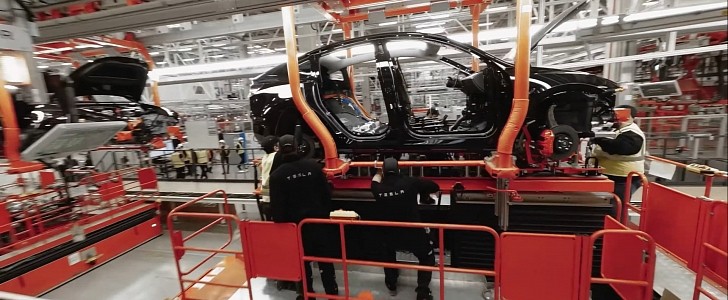We’ve seen electric-vehicle prices ballooning in the past years, sometimes faster than the rest of the car market. The price hikes were blamed on supply chain problems, inflation, and the higher price of raw materials. Nevertheless, Tesla reveals it has slashed production costs by almost 60%.
During the recently-held invite-only Goldman Sachs tech conference in San Francisco, Tesla investor relations boss Martin Viecha talked about his company’s future plans for the next five years. Among the key takeaways from his speech, Tesla’s manufacturing optimizations are impressive, akin to a third revolution in automotive manufacturing. For those who lost count, the first revolution happened in the early 1900s when Ford mass-produced the Model T. The second started in the ’70s, with Toyota’s “just in time” production model.
“EV architecture is so different from internal combustion engine, it allows for a third revolution in automotive manufacturing,” Viecha told the audience, as revealed by Insider.
Martin Viecha claims that Tesla is already there with its manufacturing improvements, which are crucial to scaling EV production to mass-market levels. Optimizations in the assembly process allowed Tesla to slash the production costs per vehicle from a whopping $84,000 in 2017 to just $36,000 in recent quarters. Almost none of these cost savings come from the cheaper battery costs. Instead, Tesla leveraged new production techniques and a new factory design to optimize production and reduce the time needed to build cars.
We’ve seen Tesla adopting the use of megacastings in the Model Y, which allows to vastly reduce the number of components in the car’s body. The technique is so good at saving time and money that other carmakers announced they would follow a similar strategy. Tesla’s new factory design for Giga Shanghai, Giga Berlin, and Giga Texas is fundamentally different from what it has in Fremont, a factory it acquired from Toyota in 2010.
All the new gigafactories are built to optimize EV production, with unique layouts that bring everything under one roof. This allows Tesla to produce faster and more efficiently, with lower production costs. Production savings could become even more important when the new gigafactories ramp up. Viecha expects that production costs will drop well below the $36,000 mark.
“EV architecture is so different from internal combustion engine, it allows for a third revolution in automotive manufacturing,” Viecha told the audience, as revealed by Insider.
Martin Viecha claims that Tesla is already there with its manufacturing improvements, which are crucial to scaling EV production to mass-market levels. Optimizations in the assembly process allowed Tesla to slash the production costs per vehicle from a whopping $84,000 in 2017 to just $36,000 in recent quarters. Almost none of these cost savings come from the cheaper battery costs. Instead, Tesla leveraged new production techniques and a new factory design to optimize production and reduce the time needed to build cars.
We’ve seen Tesla adopting the use of megacastings in the Model Y, which allows to vastly reduce the number of components in the car’s body. The technique is so good at saving time and money that other carmakers announced they would follow a similar strategy. Tesla’s new factory design for Giga Shanghai, Giga Berlin, and Giga Texas is fundamentally different from what it has in Fremont, a factory it acquired from Toyota in 2010.
All the new gigafactories are built to optimize EV production, with unique layouts that bring everything under one roof. This allows Tesla to produce faster and more efficiently, with lower production costs. Production savings could become even more important when the new gigafactories ramp up. Viecha expects that production costs will drop well below the $36,000 mark.






